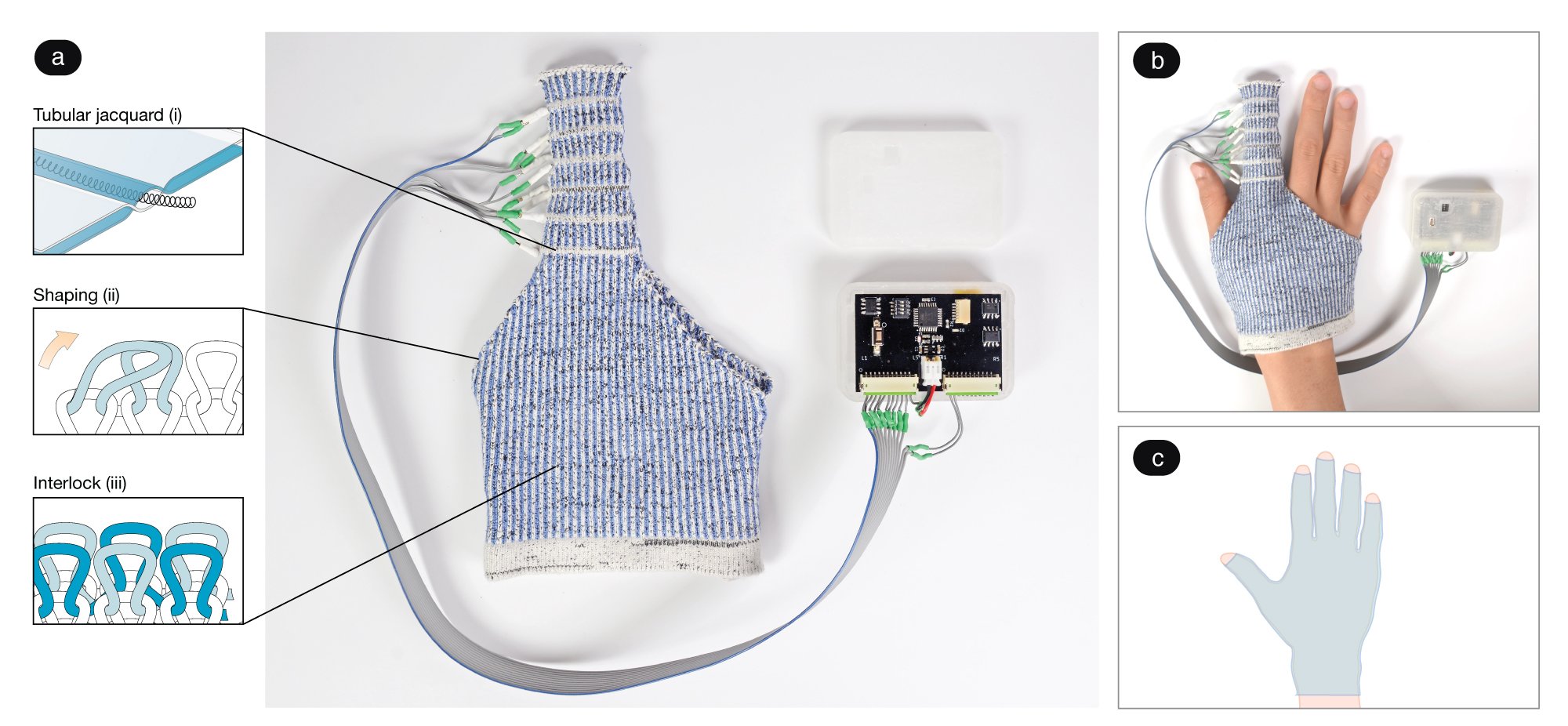KnitDema: Robotic Textile as Personalized Edema Mobilization Device
KnitDema: Robotic Textile as Personalized Edema Mobilization Device
Hand edema, defined as swelling of the hands caused by excess fluid accumulation, is a pervasive condition affecting a person's range of motion and functional ability. However, treatment strategies remain limited to time-consuming manual massage by trained therapists, deterring a widely accessible approach. We present KnitDema, a robotic textile device that allows sequential compression from distal to proximal finger phalanges for mobilizing edema.
We machine-knit the device and integrate small-scale actuators to envelop granular body locations such as fingers, catering to the shape of the hand. In addition, the device affords customizable compression levels through the enclosed fiber-like actuators. We characterize compression parameters and simulate the shunting of edema through a mock fluid system. Finally, we conduct a case study to evaluate the feasibility of the device, in which five hand edema patients assess KnitDema. Our study provides insights into the opportunities for textile-like robots to support personalized rehabilitation.
Publication:
KnitDema: Robotic Textile as Personalized Edema Mobilization Device
Heather (Jin Hee) Kim, Joan Stilling, Michael O’Dell, Cindy Hsin-Liu Kao
Proceedings of Conference on Human Factors in Computing Systems (CHI) 2023
Project Credits: Hybrid Body Lab at Cornell University, in collaboration with Weill Cornell Medicine
Research Team: Heather (Jin Hee) Kim (Project Lead), Joan Stilling, Michael O’Dell, Cindy Hsin-Liu Kao (Lab Director)
Press Inquiries: Press Image Kit: Download Here (License: CC by-NC-SA 4.0) Press Contact: Prof. Dr. Cindy Hsin-Liu Kao, cindykao@cornell.edu
Press Coverage (Selected)
· Cornell Chronicle (4/26/2023): Knitted robotic textile promising for hand edema patients
· New Atlas (4/26/2023): KnitDema glove puts the electronic squeeze on swollen fingers
· Technical Textile (4/28/2023): US researchers build knitted robotic textile for hand oedema patients
· HealthTech World (4/27/2023): Knitted wearable treats hand swelling
· The Engineer (4/28/2023): KnitDema wearable tech could improve hand edema treatment
· Medical Design&Development (4/26/2023): New Wearable Tech Promising for Personalized Rehab Devices
· mHealthIntelligence (5/5/2023): Wearable Aims to Treat Hand Edema Patients
· TrendHunter (4/27/2023): The 'KnitDema' Glove Alleviates Extremity Swelling
· Medical Xpress (4/26/2023): Knitted robotic textile promising for hand edema patients
· DailyMail (5/29/2023): How a hi-tech knitted glove could treat swollen hands
THIS PROJECT WAS SUPPORTED BY Cornell University Multi-Investigator Seed Grant #322336
KnitDema consists of machine-knitted semi-glove and hardware to compress edematous hands sequentially. The device covers the index finger and uses embedded shape memory alloy (SMA) bands to mobilize edema fluid from the fingertip to the base. (Photo: Hybrid Body Lab)
(a) KnitDema system in which the finger sleeve is knit with a combination of (i) tubular jacquard, (ii) shaping, and (iii) interlock structure. The tubular structure creates "channels" to incorporate SMA springs. The substrate also uses a shaping structure to conform the substrate to the rest of the fingers. (b) KnitDema finger sleeve device worn on a hand. (c) Future implementation of a full-hand KnitDema device. (Photo: Hybrid Body Lab)
KnitDema utilizes embedded shape memory alloy (SMA) bands to mobilize edema fluid from the fingertip to the base (from 1 to 6). The springs are enclosed within the fabric substrate. (Photo: Hybrid Body Lab)
Setup to simulate compression parameters, where pressure applied to the mock-up finger drains the water out of the finger and into the burette. This setup helped characterize compression parameters before implementing the device to patients. (Photo: Hybrid Body Lab)
Measurements used to determine changes from baseline. Measurements include (a) volume measurement, (b) circumference measurement, and (c) range of motion (ROM). ROM measures the internal angle. (Photo: Hybrid Body Lab)
Example SkinKit interfaces placed on different body locations. (Photo: Hybrid Body Lab)
Photographs of a participant’s hand before (a), after (b), and during the intervention (c). Marks from intervention indicate that the pressure is palpable and the device fits the finger snuggly. (Photo: Hybrid Body Lab)
Acknowledgements
The authors would like to express immense gratitude to Allison Howe at the Department of Physical Therapy, Cayuga Medical Center, for her profound guidance and willingness to share insight on treating and managing hand edema. The authors would also like to thank Lisa Rivera, Patricia Tufaro, David Chaudhuri at Weill Cornell Medicine, and our study participants.





